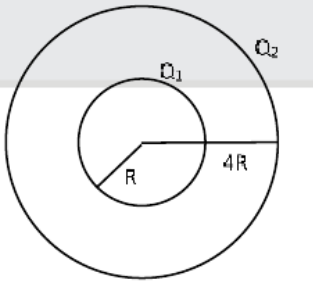A solid conducting sphere, having a charge Q, is surrounded by an unchanged conducting hollow spherical shell. Let the potential difference between the surface of the solid sphere and that of the outer surface of the hollow shell be V. If the shell is now given a change of −4Q, the new potential difference between the same tow surface is :
−2V
2V
4V
V
The correct Answer is:C
Step by step video, text & image solution for A solid conducting sphere, having a charge Q, is surrounded by an unchanged conducting hollow spherical shell. Let the potential difference between the surface of the solid sphere and that of the outer surface of the hollow shell be V. If the shell is now given a change of -4Q, the new potential difference between the same tow surface is : by Physics experts to help you in doubts & scoring excellent marks in Class 12 exams.
Updated on:21/07/2023Topper's Solved these Questions
Similar Questions
A metal sphere with a charge Q is surrounded by an uncharged concentric thin spherical shell. The potential difference between them is V. If the shell is now given an additional charge Q, what is the new potential difference between them?
View SolutionA conducting sphere is enclosed by a hollow conducting shell. Initially the inner sphere has a charge Q while the outer one is uncharged. The potential difference between the two spherical surface is found to be V. later on the outer shell is given a charge -4Q. The new potential difference between the two surfaces is : (A) V (B) −V (C) −2V (D) 2V
View Solution
Knowledge Check
A solid conducting sphere, having a charge Q, is surrounded by an uncharged conducting hollow spherical shell. Let the potential difference between the surface of the solid sphere and that of the outer surface of the hollow shell be V. If the shell is now given a charge of -4 Q, the new potential difference between the same two surfaces
A4 VB2 VC−2VDVA solid conducting sphere having a charge Q is surrounded by an uncharged concentric conducting hollow spherical shell. Let the potential difference between the surface of the solid sphere and that of the outer surface of the hollow shell be V. If the shell is now given a charge of −3Q, the new potential difference between the same two surfaces is :
A(a) VB(b) 2VC(c) 4VD(d) −2VA solid conducting sphere having a charge Q is surrounded by an uncharged concentric conducting hollow spherical shell. Let the potential difference between the surface of the solid sphere and that of the outer surface of the hollow shell be V. If the shell is now given a charge of −3Q, the new potential difference between the same two surfaces is :
AVB2VC4VD−2V
A conducting sphere carrying charge Q is surrounded by a spherical conducting shell.
a. What is the net charge on the inner surface of the shell?
b. Another charge q is placed outside the shell. Now, what is the net charge on the inner surface of the shell?
c. If q is moved to a position between the shell and the sphere, what is the net charge on the inner surface of the shell?
d. Are your answer valid if the sphere and shell are not concentric?
View SolutionTwo hollow concentric non-conducting spheres of radius the a and b(a>b) contain charges Qa and Qb respectively. Prove that potential difference between the two spheres is independent of charge on outer sphere. If outer sphere is given an extra charge, is there any change in potential difference ?
View SolutionA conducting shell S1 having a charge Q is surrounded by an uncharged concentric conducting spherical shell S2. Let the potential difference between S1 and that S2 be V. If the shell S2 is now given a charge −3Q, the new potential difference between the same two shells is
View SolutionIn the given figure there are two concentric shells find potential difference between spheres.

View SolutionThe potential difference due to small sphere in the previous question between its Surface and the surface of larger shell is
View Solution
